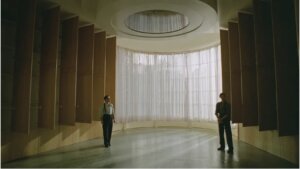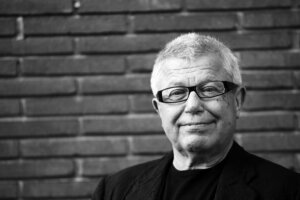Why ‘The Brutalist’ resonated so deeply with me
Brady Corbet’s film knows well the architecture of compromise and the artist’s struggles between power and design

Brady Corbet’s film The Brutalist explores the odious and corrupt world of capital, ego and power which overwhelms an architect’s resources. Photo by Focus Features
Daniel Libeskind, who designed the Jewish Museum in Berlin and New York’s post-9/11 Ground Zero plan, is an expert on the intersection of architecture and film.
It is seldom that one enters a film that resonates with one own’s life. For me, The Brutalist is such a film.
It combines the themes of the Holocaust, Israel, immigration, capitalism, architecture, and the struggles to make sense of it all.
The film depicts a successful Bauhaus-trained Hungarian architect who reaches the shores of America after his incarceration in concentration camps. As an immigrant, he enters into a world of hopelessness and poverty, of menial jobs and drug addiction. This might seem all too romantic, but it nevertheless creates a symbolic picture of the tragic loss of identity and the disillusionment with the New World.
What does the name The Brutalist really signify? Is it that the brutality of the world demands to be countered by the light of reason? Or is it that the brutal history of the 20th century and its totalitarian regimes and concentration camps have given birth to forms that symbolize the resistance to authority? Is “brutality” reason, or is it an acknowledgment that after the Holocaust (and Hiroshima) architecture will never be the same?
Without confusing the film’s title with the Brutalist style of the 1960s and ’70s, we can see throughout the film that architecture is not a mere style, but always reflects the tensions of the society in which it exists as well as the astonishing complexity of the world.

The protagonist, Laszlo Toth, played brilliantly by Adrian Brody, is asked by a fluke of chance to remodel an old library in a wealthy man’s ostentatious residence. In the process of transformation, he creates an iconic and brilliant new space, full of poetic light and clarity. Its minimalist structure, inventive craftsmanship, and liberating emptiness is stunning. The bent steel lounge chair and its accompanying lamp at the center are emblematic of the achievements of the International Style. The denouement of this scene is that the wealthy owner thinks that the purified space is a piece of garbage which has ruined his house.
As I write this, I wondered why this scene had such a potent impact on me. And then I realized that it poignantly reminded me of when I first presented the drawings of the Void in the Jewish Museum in Berlin. There was outrage that such a structure of emptiness had any place in a museum, even with its intrinsic meaning.
The scene of transformation of old into new shows the radical confrontation not merely of the form of space, but of irreconcilable world views. What are the origins of the architect’s design, of our protagonist? His architectural training is rooted in the idea of Modernism sweeping clean the old architecture built for the rich and creating stripped down and aesthetically sophisticated compositions for a democratic world.
When the wealthy owner finally realizes the value of his new library (pictures of it are published in noteworthy magazines), and looks carefully at the curriculum vitae of his architect, he embraces the architect and believes that he has finally caught the wings of the future.
He then commissions the architect to design his dream cultural center and chapel overlooking a Pennsylvanian town. And this is where Brady Corbet’s film begins to explore the odious and corrupt world of capital, ego and power which overwhelms the resources of the architect.

This too rang a bell in my head. In projects I have worked on, like Ground Zero, the struggles between power and design were visible to everyone. And the compromises necessary to reconcile these conflicting interests, in order to produce something of value, taught me that there is no other way to build architecture.
Our hero clashes with his client, who has brought to the site his own project manager and another architect. This appears innocent enough until we discover that these henchmen have been hired by the client to manipulate and subvert the integrity of the design. The architect sees these manipulations as a destruction of his work.
Laszlo Toth, the protagonist, struggles against interference with his design, contempt for his expertise, and corruption of the system. He realizes that his previous success as a younger master architect in pre-war Hungary is in sharp contrast to his diminished role in post-war America. Here he sees that the wheelers and dealers have no idea of culture but only of money; no idea of design but only of profit; no idea of excellence but only of mediocrity. Architecture is seen only as a commodity of the capitalist economy.

The dark subversions, which deal with substantial changes of materials and physical structure, are themselves countered and vanquished by Toth with the ingenious use of a non-material element of design: a ray of light, which at a particular time of day illuminates the cross at the center of the building. I, too, used such an idea at Ground Zero with the Wedge of Light. Light in architecture, as Toth showed, can rival what materials cannot. Light can displace tons of concrete by illuminating what is not present in material form, filling a gap by inserting its cause in light.
When we see Toth’s struggles to adapt to the hard life in America, we are also witness to the roads not taken by him.
Early on in the film, we hear on radio, in Hebrew, the announcement of the creation of the state of Israel. Ironically, of all the countries in the world, Israel has had the greatest impact on architects trained at the Bauhaus. They saw the young country as a utopia, in which freedom and equality would offer the fruits of a European experiment which ended catastrophically with the Nazi closure of the Bauhaus and subsequent exterminations. Israel became the only country in which Bauhaus architecture continued. The White City born in Dessau was realized in Tel Aviv with more than 4,000 Bauhaus buildings. What a strange destiny of dreams.
There is a scene in a cramped apartment in New York, where Laszlo and his wife talk with his pregnant niece about her imminent plan to emigrate to Israel. They try to discourage her and her husband from leaving by pointing out the horizon of difficulties they will encounter in the young Jewish state. His niece, however, is resolute about leaving, and does so. Implicit in his silence is this possibility that success is counted best by those who are willing to fail.
As I conclude these thoughts, I want to reflect on the beginning scenes of the film, where the architect emerges from the darkness of the hold of the ship into the light of the Statue of Liberty. And perhaps, this is the scene that best illuminates the struggles, pains and violence we have seen in the film.
The sighting of the Statue of Liberty from the deck of a ship filled with immigrants is something Lazlo Toth and I share. Despite setbacks of American democracy, turmoil of politics, dictatorship of digital technology, reactionary forces and the rise of antisemitism, this one emblem still stands symbolically to define the gates of New York and America:
Give me your tired, your poor,
Your huddled masses yearning to breathe free,
The wretched refuse of your teeming shore.
Send these, the homeless, tempest-tost to me,
I lift my lamp beside the golden door!
Nothing symbolizes the trials and hopes of the immigrant better than the scene in the film in which the unemployed, demoralized and suffering Laszlo Toth is digging a large mound of coal with a shovel. The mound of blackness and sweat is visceral. Sometime, much later in the film, when he is finally recognized as an important architect, we see him in a studio using charcoal in broad strokes as he sketches a design.
The same material, coal, represents the two extremes, the hardest labor a man can do and the heights of creativity to which he can ascend. The brutality of time, accidents of life and random encounters shape destiny more than calculation and dreams. The brutalist seems to be one who is thrown into time and finds his destiny in that uncertainty. He is shaped and rooted in a world of uncertainty, instability, suffering and turmoil.
The Brutalist is a brilliant film. When I think of The Fountainhead and its self-impressed hero and the ludicrous film Megalopolis whose futurist is drunk with himself, I see the brutalist Laszlo Toth as a mensch who has prevailed without selling his soul.
A message from our Publisher & CEO Rachel Fishman Feddersen

I hope you appreciated this article. Before you go, I’d like to ask you to please support the Forward’s award-winning, nonprofit journalism during this critical time.
We’ve set a goal to raise $260,000 by December 31. That’s an ambitious goal, but one that will give us the resources we need to invest in the high quality news, opinion, analysis and cultural coverage that isn’t available anywhere else.
If you feel inspired to make an impact, now is the time to give something back. Join us as a member at your most generous level.
— Rachel Fishman Feddersen, Publisher and CEO






















